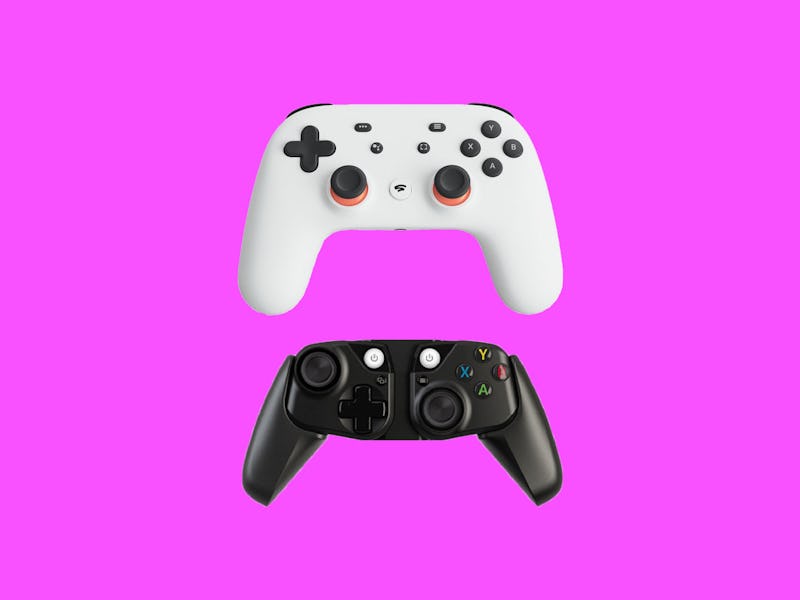Stadia vs. xCloud: How Future Cloud Gaming Controllers Could Stack Up
What will you be gaming on?

Google Stadia and Microsoft xCloud are shaping up to be the Yankees and Red Sox of cloud gaming. Both services will bring a unique roster of games, and both will offer their own specialized controllers. The rivalry will be intense.
The promise of cloud gaming services is essentially always the same: Access to your favorite titles across all of your smart devices. To be re-optimized for cloud gaming, controllers will need to be more lightweight, sleek, and compatible across various tablets and smartphones.
Stadia has long hyped its mostly traditional-looking controller, claiming that it has the ability to deliver as close to a lag-free experience as possible with cloud gaming. Microsoft has yet to announce if xCloud will even receive its own controller, but it has been experimenting unique designs.
Most recently, Microsoft was granted a patent by the United States Patent and Trademark Office on July 9 for slide-in grip controllers that could eventually be sold to xCloud users. The original designs were even mocked up in a Microsoft Research paper published in October 2018.
The included blueprints and renders in both documents are the most compelling evidence that xCloud will launch with distinct hardware. But that doesn’t necessarily mean the controller will launch with Microsoft’s cloud gaming service. And of course, Microsoft could scrap the ideas in the outlined patents entirely.
Here’s how the two controllers differ so far, and what these decisions indicate about the two upcoming services.
xCloud vs Stadia: Controller Form Factors
Google Stadia opted for a traditional console controller design, while Microsoft is spitballing much more audacious ideas that look a lot like the Nintendo Switch’s Joy-Con controllers.
At a glance, the Stadia controller looks like a fusion of a PlayStation 4 and Xbox One controller. Its soft, rounded edges resemble what you will find with Microsoft’s console, but its side-by-side joystick placement is identical to Sony’s DualShock 4. It’ll require a mount if users want to play on the go.
Microsoft’s “Versatile Controller for Mobile Gaming”, on the other hand, can slide-in and clip onto the sides of tablets and smartphones. It also comes with different-sized grips to fit any player or device, though it keeps the iconic button, joy-stick, and D-Pad layout of every Xbox controller before it. The Microsoft Research brief stated that the success of Nintendo’s hybrid console inspired this design.
Considering only sheer form-factor, Microsoft has the upper hand with its unique design. It’s compact, doesn’t require you to buy a mount, can be customized, and can be fitted to any device. Stadia’s controller is sleek and colorful, but looks like all of its predecessors.
xCloud vs Stadia: Controller Price
On its own, the Stadia controller will cost $69. But users can purchase the Stadia Founder’s Edition bundle for $129 to get an exclusive blue controller, a 4K-supporting Chromecast Ultra, a three-month Stadia subscription, an additional three-month subscription for a friend, and first dibs on a username.
xCloud’s controller isn’t official yet, so we can only ballpark a price. Seeing as Nintendo’s Joy-Cons can cost up to $80 that price point wouldn’t be surprising. Additional grip sizes, if that’s a feature, could take the price over $100.
xCloud vs Stadia: Controller Release Dates and Compatibility
Stadia will officially launch in November, so anyone who has pre-ordered the Founder’s Edition should expect their controller to arrive in the fall. But there’s a catch.
Google Stadia's first bundle includes the necessary hardware, a special edition controller, and a few other extras.
The tech giant updated Stadia’s FAQ page on July 3 to say the service will only work with Google Pixel 3 smartphones, all laptops running the Chrome browser, and all TVs with a Chromecast at launch. There won’t be any tablet support at first. A Google spokesperson told Inverse that the company will share a list of more supported devices in 2020.
Microsoft xCloud still does not yet have a firm release date, but will begin public beta testing this fall. That experience likely won’t include the patented controller, which could come to market whenever xCloud is officially launched. But xCloud is already compatible with more mobile devices.
Inverse tested xCloud at E3 2019 on a Samsung Galaxy S10+ and the gaming-centric Razer Phone 2. Samsung is the most popular smartphone brand in the world. When xCloud does roll out, it will be more widely available on mobile devices from the start.
Patent blueprint of the xCloud controller's charging dock.
xCloud vs Stadia: Unique Features
The Stadia controller will come with three defining features, two of which have never been seen on another game controller before:
- Google Assistant Button: Users will be able to press a button on the center-left of the device to ask the voice assistant for help in-game. In the longer term, this function will eventually be multipurpose if developers come up with imaginative ways to incorporate the function into games.
- Capture Button: To the right of the Google Assistant button lives the Capture button. It serves as a shortcut to let gamers take screenshots or record their nuttiest in-game moments which they can then share with friends or upload to YouTube.
- Wifi Enabled: Unlike traditional gaming controllers that are directly synced to consoles, Stadia’s will use wifi to connect to Google servers. The company claims this will help reduce lag for any game hosted directly from Google’s servers.
Based on Microsoft’s prototype, it looks like a would-be xCloud controller’s key features will be portability and customization. Besides that, the research paper also mentioned there would be a small USB charging dock that both controller components can be rested on to juice up after a game session.
While xCloud and Stadia will be offering very similar services, the controllers they launch with could be dramatically different.